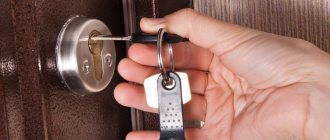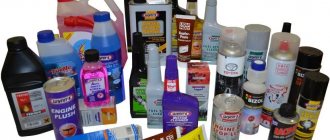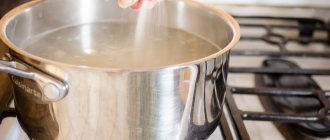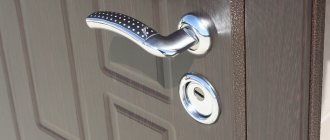High-quality lubricant for entrance door locks can extend the life of the mechanisms several times. With the current abundance of different types of compositions, it can be difficult for an ordinary person to make a choice. Next, we will look in detail at how to lubricate the front door lock, how to lubricate it, which lubricant is best for a particular mechanism, and which lubricant is absolutely not suitable for entrance door locks.
Choosing a lubricant for entry door locks
Lubricant for entrance door locks - 8 proven compounds
High-quality lubricant for entrance door locks can extend the life of the mechanisms several times. With the current abundance of different types of compositions, it can be difficult for an ordinary person to make a choice. Next, we will look in detail at how to lubricate the front door lock, how to lubricate it, which lubricant is best for a particular mechanism, and which lubricant is absolutely not suitable for entrance door locks.
Choosing a lubricant for entry door locks
Why do you need to lubricate the door lock?
Locks and hinges are two pain points of any door, but if the creaking of the awning causes only slight discomfort, then a lock that jams at the most inopportune moment can lead to serious problems.
The lock mechanism consists of dozens and sometimes hundreds of small metal parts; if they are not lubricated, then from constant friction, even under ideal conditions, metal shavings appear, which sooner or later will cause problems.
Good lubrication repels moisture and dust from the mechanism, which means the lock will not rust or become clogged with debris. At the same time, low-quality compounds, on the contrary, attract dust and moisture.
Cylinder lock heads are perhaps the most complex, which is why they cannot be repaired.
Causes and consequences
Dust gets into it through the lock cylinder.
- These smallest fractions act on all elements of the mechanism as an abrasive. The result is their increased wear; and this process is avalanche-like. The metal particles (chips) themselves begin to have an identical effect on the lock.
- Changes in the geometry of parts due to abrasion lead to incorrect operation of the lock, expressed in the key slipping, incomplete release of the tongue (bolts) from the body, and so on.
- Dust, collecting in lumps, can block the free movement of parts of the lock mechanism.
Rust
It cannot be avoided on metal, especially if it is an entrance door or installed in an opening leading to a room with excess humidity and temperature changes; The appearance of condensation inside the lock is guaranteed. The effect is almost the same as that of dust; but with deeper consequences - the gradual destruction of “hardware”. And this reduces both the durability and strength of the bolt.
Poor sliding of moving parts
No detailed comment is needed here. If you do not regularly lubricate the mechanism, then pretty soon problems will arise with it - tight turning of the key, jamming of the cylinder, limited movement of the bolts, and the like.
When is it necessary to treat a lock?
It has been noticed that our people are trying to find out what to lubricate the door lock after the mechanism begins to creak, jam and generally behave inappropriately. Unfortunately, at this moment it may be too late, if the lock is acting up, it is not a fact that you will be able to return it to its original ease of movement, but it’s worth a try.
A good owner prevents all constipation in the house in advance. There can be only one lubricant, but the period of work is selected depending on the location of the mechanism:
- External doors that open onto the street are given preventative maintenance at least once a quarter (3 months), and locks can be lubricated more often in winter;
- doors in the entrances of apartment buildings should be lubricated once every six months, if the entrance is clean and heated, then preventive maintenance can be done once every 8 - 10 months;
- Constipation in warm rooms, for example, in offices, is lubricated once a year.
conclusions
Based on all of the above, based on our many years of personal experience, we believe that in the vast majority of cases, locks cannot be lubricated. Not only will this not solve your problems, but it will also create new ones.
We repeat time after time: if your lock or locking system is not working correctly, do not try to solve the problem yourself - consult a specialist. Including on our forum about locks and doors>>>
Using leading questions, a specialist is able to find out the causes of your problem and suggest clear ways to solve them.
Lubricant selection - 8 proven formulations
No matter how strange it may sound, buying a good lubricant for locks and hinges with the current choice of models is problematic, especially if a person is far from this topic. Not counting folk remedies, there are 8 types of lubricant for door locks on the market.
| How to lubricate the front door lock | |
| Photo | Recommendations |
| No. 1 Machine oil Liquid oil that can be found at any hardware store. Professionals call it a spindle. Sold in plastic vials equipped with a pipette, the price is quite reasonable.
Silicone lubricant for door locks is now considered the queen of such compounds. This is the best lubricant for entrance door locks for the winter; it is not afraid of moisture, frost and dust. In addition, it is great for car locks. True, the cost of silicone grease is several orders of magnitude higher than that of competitors. But buying it now is not a problem. | |
| No. 3 Graphite Graphite dust is widely used to lubricate lever locks and some deadbolt-type locks.
An excellent product that is suitable for all types of locks, but there is a small nuance. WD-40 eats away rust well, so it is often used to resuscitate jammed and broken locks, and when the mechanism starts working, a profile compound, for example, graphite or silicone lubricant, is poured into it. | |
| No. 5 Solidol Refers to calcium types of lubricant. It has a thick and viscous consistency, so it is better to lubricate hinges on gates and locks with large parts of the mechanism with grease. | |
| No. 6 Litol Refers to lithium compounds. From the point of view of lubricant for locks, litol can be safely called the sibling of solid oil. It has a similar consistency and is used for the same mechanisms. | |
| #7 Gun oil Until silicone grease appeared, gun oil for lubricating locks was considered the best option. The compositions are universal and suitable for everything, but they are expensive, plus you can’t buy gun oil in every store. | |
| No. 8 Graphite lubricant The same graphite dust, only diluted in a neutral liquid filler. It is more convenient to use this composition, plus there is less waste from it. | |
Selecting lubricant for different locks
Before lubricating the lock of the metal entrance door, you need to figure out what mechanism you have. At first glance, it may seem to an inexperienced person that there are a huge number of locks, but this is not entirely true.
There are really a lot of models, while there are no more than a dozen types of mechanisms, and if we talk about popular systems, then there are about five of them. Details about choosing a lock for the front door are described and shown in the video “HERE” .
- In cylinder locks, the weak point is the security cylinder. The mechanism consists of many small parts, and most importantly, the cylinder heads cannot be disassembled, so liquid compounds are used for lubrication. Ideally, it is better to take silicone or weapons-grade lubricants. You can use a spindle on driveway and interior doors.
- Most lever locks are lubricated with graphite dust or its liquid equivalent. Deadbolt locks in apartments and private houses are usually lubricated with machine oil, and for large mechanisms installed on garages and gates, litol or grease is better suited.
- Padlocks belong to the budget line, so they are traditionally lubricated with a spindle, although silicone grease is still better.
Each type of lock has its own lubricant, with WD-40, gun oil and silicone grease considered universal.
What not to lubricate locks
There are now a lot of home-grown craftsmen on the Internet who advise people absolute nonsense, for example, often when asked how to lubricate the cylinder of the front door lock, these masters without a twinge of conscience recommend pouring sunflower or olive oil into it.
Household vegetable oils strongly attract dust, so after such an injection the lock will work for a maximum of six months, and then it will begin to act up and eventually jam.
The same can be said about animal fats; lard, rendered fat and other similar things cannot be used to lubricate locks. Among other things, animal fats also set quickly in the cold, so in winter this lubricant can act like glue, with all the ensuing consequences.
But the highest aerobatics of irresponsibility, and simply stupidity, would be the use of waste machine oil to lubricate the locks of the front door. The processing involves a huge amount of fine metal dust and other things harmful to mechanics. The answer lies in the name - this oil has already used up, there is only dirt left and people are trying to pour this dirt into their castle.
Locks cannot be lubricated with non-core oils, but it is especially dangerous for mechanisms to use engine oil.
How to lubricate a lock with your own hands
Advice! Before lubricating the lock, it is advisable to remove all the decorative trims from the door, this will make it easier for you to get to the mechanism, and at the same time remove the dust that has accumulated under them.
Before lubricating the lock, it is advisable to remove the door linings.
Lubrication of any mechanism begins with cleaning it; I do not encourage you to take out and disassemble the lock, just wipe away visible dirt. If the system is acting up, then to clean it and return it to normal operation there is such a wonderful remedy as WD-40. Inject it into all accessible holes and leave the lock alone for 30 - 40 minutes.
Next, you need to wipe off all the excess lubricant that has leaked out during this time, after which you need to insert the key and turn it in both directions at least 5 - 7 times. Usually, after this procedure, excess lubricant pours out of the mechanism along with dirt, which you also remove.
Now it's time for real lubrication. Take the profile composition and first pour it into the keyhole. Then, in turn, lubricate the retractable bolts, the tongue and the rotary handle mechanism, if any. It all ends with the linings returning to their place.
Each lock usually has special holes for lubrication; their location can be found in the instructions for the mechanism; if there is none, then lubricant is poured into the well and the main components of the mechanism
Advice! Since you have already started lubricating the lock, it would not be a bad idea to lubricate the door hinges at the same time, everything is much simpler there; in the upper part of the hinges of the front door there is usually a special hole where you need to drop the lubricant. Keep in mind that graphite lubricant is not suitable for awnings.
How and with what to lubricate the lock or locking mechanisms?
WD-40 lubricant is the most popular product.
As practice shows, most people, when a problem arises with a lock, use WD-40 lubricant; in fact, such a lubricant does not have the necessary properties, since this liquid contains 50% white spirit, 15% mineral oil, and carbon dioxide. The effect of such a lubricant is temporary, since the white spirit evaporates and mineral oil remains, and subsequently dust and small particles stick to the internal mechanisms; therefore, we do not recommend lubricating the cylinders, as well as the internal mechanisms of the locks.
Graphite grease.
The best solution is graphite lubricant, as it has good sliding properties. Graphite is a natural black substance that is antistatic, can withstand high temperatures and, importantly, does not corrode. But we are not talking about graphite lubricant, where mineral oils are mixed with graphite, but about graphite powder.
How to make graphite powder?
If it is not possible to buy graphite powder, then it can be made at home, fortunately for our tasks we do not need a lot of it. Graphite is found in graphite pencils. It is not difficult to remove the graphite rod from the pencil; then you need to crush it, for example into a tablespoon, and your lubricant is ready. The disadvantages of graphite lubricant are the difficulty of its use, since in order to produce good lubrication you need to disassemble the lock or locking mechanism.
Silicone Grease.
Silicone-based lubricant is the most affordable and reliable substance used in various areas of everyday life, and is also well suited for lubricating locks.
Properties and qualities of silicone grease:
- The lubricant has good fluidity - this makes it easier to get into all hard-to-reach parts of the mechanisms.
- chemically inert to all types of plastic and rubber.
- has the ability to adhere well to the surface.
- protects against corrosion very well.
- does not burn and is not afraid of sparks, as well as open fire.
- has excellent water-repellent properties.
- not susceptible to temperature influences.
Silicone grease is sold in pressurized containers, this greatly facilitates its penetration into the internal parts of rubbing mechanisms, also due to the fact that this substance perfectly repels water and can be used at subzero temperatures, it is an indispensable means of preventing the lock from freezing.
Lubricating the lock with silicone grease is the most optimal solution to this problem, both for prevention purposes and for further problem-free operation.
When is treatment necessary?
Door locks need to be lubricated regularly, because they are responsible for the safety of the house and its inhabitants. Most often, treatment is carried out only when problems are noticed in the operation of the mechanism. It is recommended to lubricate the constipation at least once a year to prevent it from becoming stuck.
If we are talking about interior doors in an apartment, which are used more often, then the procedure must be carried out once every 6-8 months. For those who live in private houses, it is good to carry out the treatment once every 3-4 months.
When coating the latch with oil, lubricate the door hinges well. The fittings need treatment both if they are used frequently and if they have not been used for several years.
Why do this?
If you periodically lubricate the lock, it will be easier to turn the key. Irregular lubrication will allow dust to accumulate in the mechanism, making it difficult to use.
The most dangerous thing for any constipation is rust. Because of it, structural elements are gradually destroyed. Over time, it becomes impossible to turn the key.
The properties of lubricants make it possible to protect constipations from dust, dirt and rust, and prevent mechanism breakdown and rapid wear.











